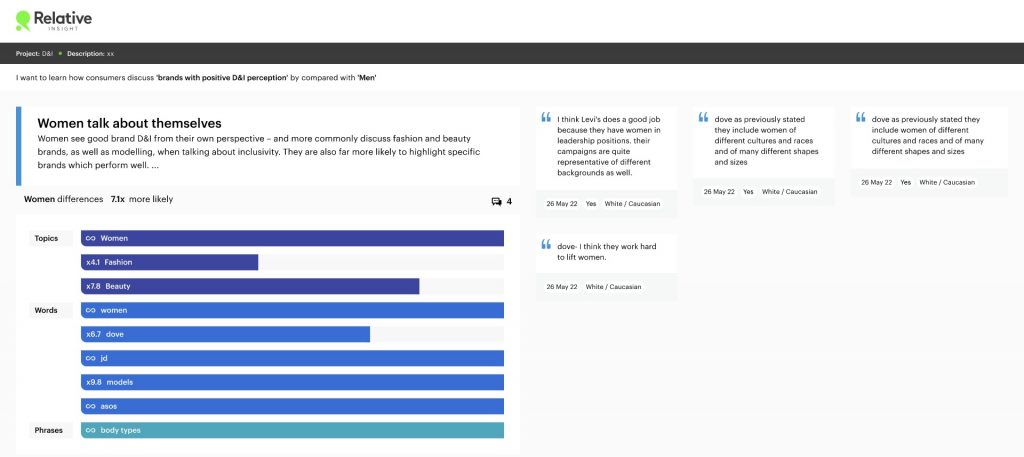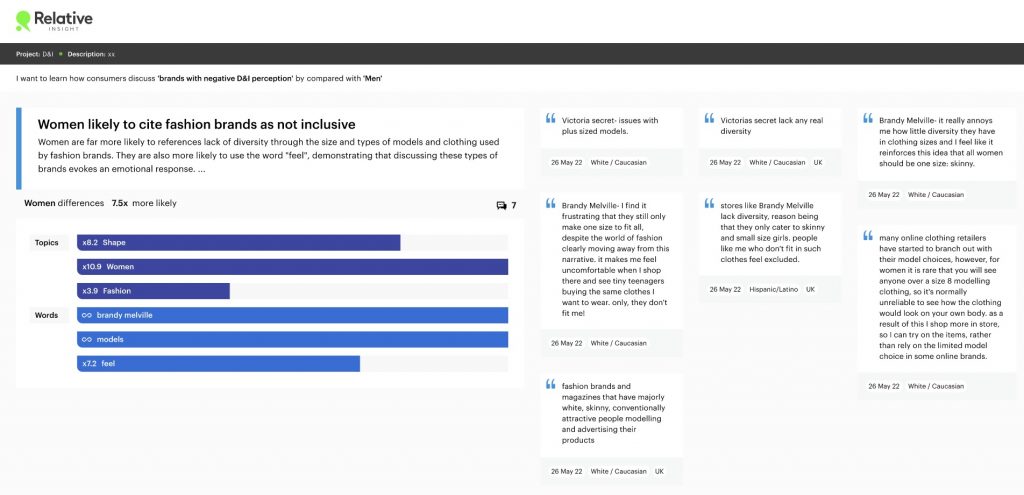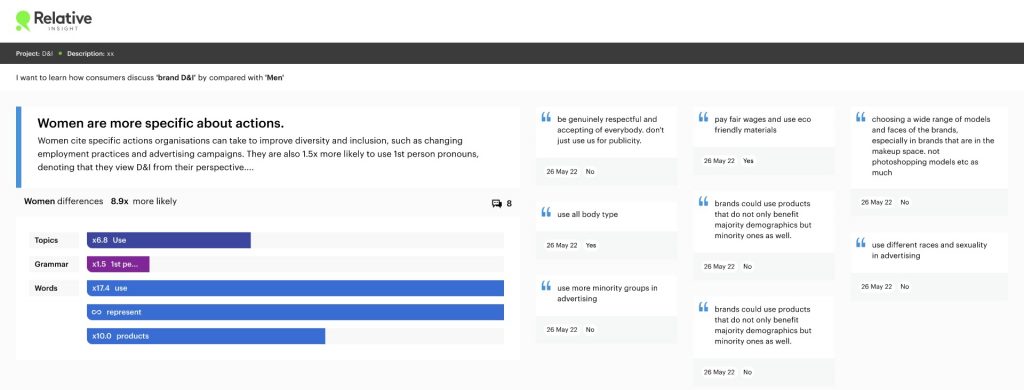Brand perception monitoring: analyzing survey open-ends to learn how different genders view brand inclusivity

Diversity and inclusion. Two simple words which evoke a multitude of reactions depending on your experiences. Your interpretation of diversity and inclusion could range from considering brand perception and representation in entertainment and politics, to thoughts about personal lived experiences.
In today’s world, consumer buying decisions go beyond product and price. Brands’ social impact and overall reputation play a huge role in who people buy from. In a world where your diversity and inclusion policy impacts buying decisions, understanding how your brand inclusivity is perceived is critical.
However, with diversity and inclusion meaning distinct things to different people, trying to group people’s thoughts on this topic into one catch-all definition runs counter to the nature of D&I. This also makes it harder for brands to speak to consumers in a resonant way.
To kickstart a conversation into what diversity and inclusion means to a wide range of consumers, we conducted a survey of 800 people in the UK and US. Using a range of open-ended questions, we gather their thoughts on a full array of D&I topics, including what the phrase means to them and how organisations and brands’ D&I practices stack up.
Upon completion of the survey, we uploaded the open-ended responses into our text analytics platform and grouped responses based on various attributes including gender, race and sexuality, and other groups talk about diversity and inclusion. The complete report on our findings investigates multiple areas, but here we’ll examine how different genders perceive brands’ D&I efforts.
Introduction to our brand perception survey questions and responses
To obtain our brand perception research data for this study, we asked survey participants the following open-ended questions:
- Are there any brands or organisations that you think do a good job from a diversity and inclusion perspective?
- Are there any brands or organisations that you choose not to engage with on principle?
- What could brands be doing better from a diversity and inclusion standpoint?
97.75% of respondents identified as male or female, making a comparison between these two groups the most revealing and insightful.
Women define brands’ D&I through their own perspective
A common theme from survey responses across all groups who have an unequal stake in society was that they talk about D&I from their own point of view and experiences. In this context, women strongly aligned D&I with their own experiences. They were infinitely more likely to use the word “women” in their responses and judged brand inclusivity based on how they portrayed women.
When it came to listing brands doing a good or bad job in this area, women were far more likely to list specific examples, including Dove, JD Sports and Glossier. These focused on the fashion and beauty sector and the inclusivity of models used in advertising campaigns – both body type and race. Overall, women were 9.8x more likely to mention models than men.


In comparison, men tended not to use specific examples – they were 2.3x more likely to use maximizer words like “many” or “most”. When they did tend to list specific examples, they were big brands across a number of sectors – including Disney, Samsung and Microsoft.


Women feel, men observe
When it came to brands doing poorly, women were again more specific about what was going wrong. Responses once again focused on the inclusivity of advertising and modeling for fashion and beauty brands, particularly the use of skinny models.
They were also 7.2x more likely to use the word “feel”, demonstrating that brands who are getting it wrong are generating negative emotive responses from women. Female respondents also cited specific brands they felt were not inclusive or diverse.


Once again, men were vaguer when asked about the brands they disliked. The organizations they mentioned were large corporations that they had heard things about, rather than brands they had personal experiences or feelings towards.


Brand inclusivity research finds women are more specific on organizational actions
Throughout every part of this brand perception study, women were far more specific in articulating their opinions than men were. When asked what brands could do to improve their diversity and brand inclusivity, women cited specific examples of policies organizations should adopt:
“Brands could use products that do not only benefit majority demographics but minority ones as well.”
“Use all body types”
“Choosing a wide range of models and faces of the brands, especially brands that are in the makeup space. Not photoshopping models etc as much.”


Conversely, men were again more likely to generalise when asked about brand actions. They infinitely used the phrase “more diverse” than women and, rather than cite specific courses of action organisations can take, they listed vague, non-targeted activities.
“Being more open minded.”
“Nothing in mind. I feel brands are doing a good job already.”


Interestingly, when it came to thinking up specific courses of action, men were 2.3x more likely to reference CSR and corporate structures – placing the emphasis on business leaders to ‘do something’ and diversity and inclusion.


D&I perception of brands reflects other touchpoints
These findings on brand perception reflect the other aspects of diversity and inclusion covered in our report.
Across different groups, those with inbuilt societal advantages used vague and imprecise language, while those at a disadvantage were more likely to cite specific examples and use clear, definitive words and phrases.
Find out more about brand inclusivity insights from our open-ended survey analysis by downloading the report.
We are holding an in-depth discussion covering the report’s findings at our Text Summit event – sign up here.

